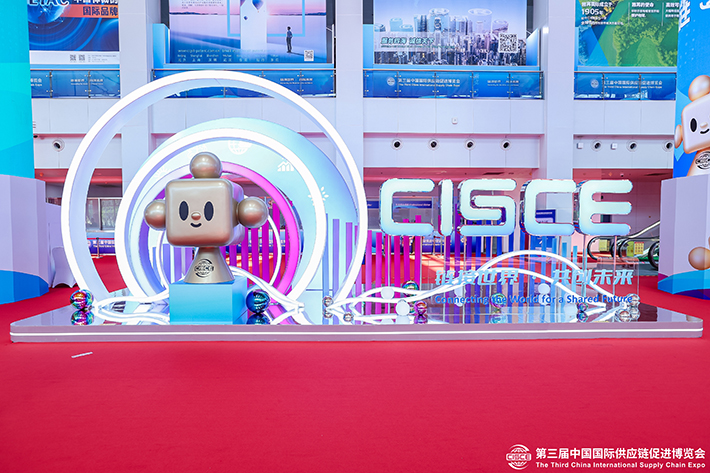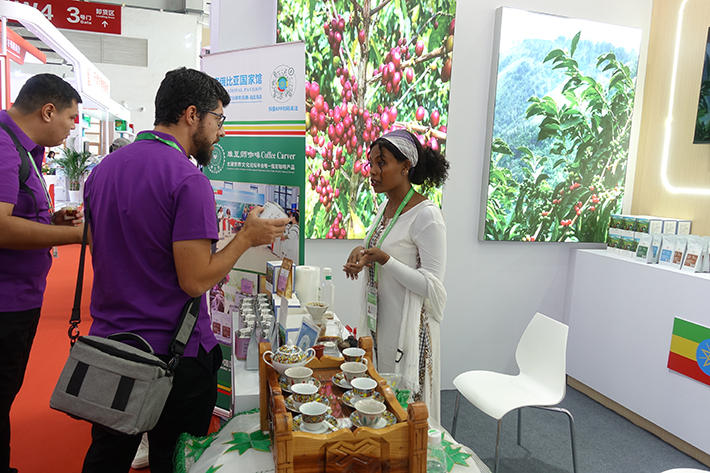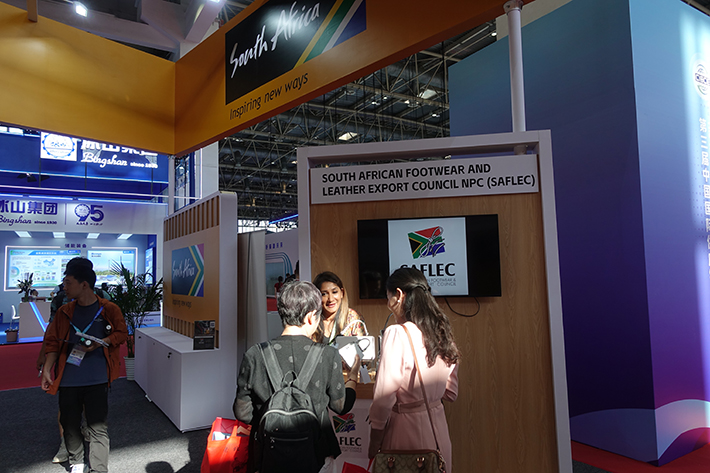|
||||||||||
| Home Top News Economy/Tech Culture/Sports China in Foreign Eyes Green Development Videos Intangible Cultural Heritages |
|
||||||||||
| Home Top News Economy/Tech Culture/Sports China in Foreign Eyes Green Development Videos Intangible Cultural Heritages |
| ChinAfrica |
| Global Stage for Industrial Synergy |
| Expo promotes trade, investment, cooperation, innovation, and exchanges pertaining to the global supply chain system |
| By Li Yin | VOL.17 August 2025 ·2025-07-25 |

The venue of the third China International Supply Chain Expo (COURTESY)
From 16 to 20 July, the China International Exhibition Centre in Shunyi, Beijing, was bustling with energy as it hosted the third edition of the China International Supply Chain Expo (CISCE). As the world’s first national-level expo focused on supply chains, the CISCE has quickly emerged as a signature platform for international industrial collaboration, offering a window into the latest technologies, services, and policy trends shaping global economic interdependence.
This year’s event, themed “Connecting the World for a Shared Future,” underscored China’s role as a key contributor to the building of resilient, inclusive, and collaborative supply chains amid a shifting global economic landscape.
During the opening ceremony held on 16 July, Shipokosa Paulus Mashatile, deputy president of South Africa, delivered a keynote address in which he encouraged all stakeholders to seize opportunities, foster partnerships and collectively shape the future of supply chain management to build a more connected, resilient and prosperous world.
In a powerful departure from its historical role as an exporter of raw materials, African countries emerged at the CISCE 2025 as proactive participants in global supply chains. Their growing presence signalled not only a deepening of China-Africa economic ties but also a rising interest from African nations in playing a more active and integrated role in global supply chain systems.
From exhibition to ecosystem
The event focused on six major supply chains - Advanced Manufacturing, Clean Energy, Smart Vehicles, Digital Technology, Healthy Living, and Green Agriculture - as well as a Supply Chain Service area.
The expo gathered 651 enterprises and institutions alongside over 500 of their upstream and downstream partners from 75 countries, regions, and international organisations, over one-third of which were from overseas, forming a comprehensive and cooperative ecosystem.
The event not only attracted leading multinational corporations but also welcomed small and medium-sized enterprises, innovators, and service providers from emerging markets, including an expanding cohort from African nations.
During the opening ceremony, the China Council for the Promotion of International Trade (CCPIT) and representatives of the global business community reached a consensus and jointly issued the Beijing Initiative. The initiative outlines commitments to promote innovation-driven development, accelerate the digitalisation of supply chains, foster green and sustainable practices, and deepen engagement with business communities worldwide.
At its core, the event was more than just a showcase of cutting-edge technologies, innovations, products and services, but a platform for matchmaking, commercialisation of new technologies, and initiation of new business partnerships.
It placed a strong emphasis on synergy and collaboration, enhancing communication and exchange, and building a global platform for mutually beneficial cooperation. It helped enterprises to expand their networks, facilitated resource aggregation across upstream and downstream industries, and accelerated the transformation of emerging technologies. By turning technologies into products and linking products to services, the expo stimulated economic vitality and contributed to improving the quality of life.
It served not only as a grand stage for win-win cooperation between Chinese and international business communities, but also as a new symbol of China’s high-level opening up. It showcased China’s determination and concrete actions to expand opening up and contribute to global economic recovery.
Throughout the five-day event, the exhibition halls were alive with exchanges of ideas and products, and filled with a shared sense of purpose: building inclusive and efficient supply chains that can withstand global disruptions and promote mutual benefit.

An Ethiopian exhibitor introduces her products to visitors during the third CISCE on 16 July (LI YIN)
Innovation at the forefront
Artificial Intelligence (AI) continues to amaze the world with its rapidly evolving capabilities and the breadth of products and services it powers. At the opening ceremony of the CISCE on 16 July, Jensen Huang, founder and CEO of US tech giant Nvidia, underscored the transformative impact of AI on the global supply chain.
“AI will be central to every industry, company, product, and service,” he said. “It has sparked a new industrial revolution and presents a tremendous growth opportunity for China’s supply chain ecosystem.” Huang also highlighted China’s open-source AI development as a catalyst for global progress, providing every country and industry the opportunity to participate in the AI revolution.
This vision of AI-driven innovation was brought to life at the CISCE LaunchPad event, a new feature of this year’s expo, serving as a dedicated platform for showcasing the latest breakthroughs in global supply chains. It hosted 24 official product launch events and featured over 100 cutting-edge innovations from around the world.
One of the standout innovations launched on 19 July was Global YDT, an industrial network platform developed by Optimise Integration Group from China that specialises in temperature-controlled agricultural products. This platform exemplifies how AI is being used to reshape supply chain operations.
Global YDT integrates an AI-powered Agent that helps users to identify the most suitable suppliers based on specific business needs. When a demand is entered, the Agent scans relevant data from multiple sources, conducts in-depth analysis of risks and benefits, and delivers tailored matchmaking solutions. By providing smart, data-driven insights, the platform streamlines decision-making and enhances overall supply chain efficiency.

Nerisha Jairaj introduces products to visitors during the third CISCE on 16 July (LI YIN)
Africa steps into the spotlight
Between its aisles and themed exhibition zones, a vibrant African presence materialised through national pavilions and independent booths of 11 countries and the African Union Mission in China.
The exhibition space resonated with the colours, textures, and aromas of the continent - artisanal crafts created by skilled hands, beauty products made with organic local ingredients, medical devices reflecting emerging African innovation, and agricultural goods representing regional resources. Exhibitors brought a broad range of products and services that reflected the diversity and dynamism of the continent’s emerging industries.
At the South Africa National Pavilion, the opening ceremony drew high-level attention. Ren Hongbin, chairman of the CCPIT, attended the ribbon-cutting ceremony alongside Deputy President Mashatile and other senior officials and business representatives from South Africa. The pavilion featured 30 South African companies, covering sectors such as pharmaceuticals, mining resources, personal care, fashion and textiles, and creative industries.
Speaking at the ceremony, Mashatile described the CISCE as one of the most significant platforms for showcasing the diversity of South African exports and promoting economic engagement between South Africa and China.
Among the African entrepreneurs present was Nerisha Jairaj, executive director of the South African Footwear and Leather Export Council. No stranger to China, Jairaj had previously participated in the China International Import Expo in 2024, where she experienced resounding success: all the products she brought got sold out, and she gained valuable insights into the Chinese market and consumers.
“I’m here for three things,” Jairaj stated. “We’re looking for Chinese consumers, we’re looking for companies that can distribute these products in China, and we’re also looking for investment in South Africa.” She underscored the need for strategic partnerships, particularly in component manufacturing.
By showcasing the latest developments in the field of supply chain management, this year’s CISCE promoted trade, investment, cooperation, innovation, and exchange within the global supply chain system.
|
||||||
| About Us | Contact Us | Advertise with Us | Subscribe |
| Copyright Beijing Review All rights reserved 京ICP备08005356号-5 京公网安备110102005860号 |